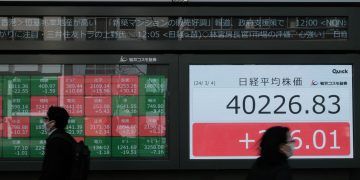In the midst of strong market rallies, historical data, and optimistic earnings reports, investors are beginning to ask whether the economic storm that some indicators predict is truly on the horizon. The stock market has been experiencing impressive growth, yet certain signals from leading economic indicators, like the Conference Board’s Leading Economic Index (LEI), suggest a potential downturn. So, why are markets seemingly ignoring these recession warnings?
The disconnect between the performance of equities and signals of a slowing economy is nothing new, but as we look into 2025, the gap appears more pronounced. The LEI, a forward-looking economic indicator, has been flashing cautionary signs, but stock markets, driven by optimism over corporate earnings, have largely disregarded these warnings. This article dives into the potential causes of this discrepancy and explores whether investors are being overly optimistic or simply overlooking vital data.
What is the Leading Economic Index (LEI)?
The Leading Economic Index (LEI) is a composite of ten key economic indicators designed to forecast economic activity over the next three to six months. Published by the Conference Board, the LEI includes components such as stock prices, new manufacturing orders, unemployment claims, and consumer expectations. Its primary purpose is to serve as an early warning system for potential economic slowdowns or recessions.
When the LEI declines for several months in a row, it often signals a recession in the near future. Historically, the LEI has been a reliable predictor of downturns, with its declines often preceding economic contractions. Yet, despite recent drops in the LEI, the stock market has remained resilient, leading some to question whether investors are out of sync with the economic reality.
The Divergence Between the LEI and the Stock Market
It is no secret that the stock market often moves on sentiment and expectations, rather than the raw data of economic indicators. This has led to a situation where equity markets may be focusing more on short-term optimism, such as corporate earnings and government policy measures, while largely ignoring longer-term economic signals. In 2025, this phenomenon is amplified as markets continue to climb despite a steady deterioration in the LEI.
The stock market is often forward-looking, and investors may be pricing in a return to growth, assuming that current economic concerns are transitory or manageable. However, the LEI’s warning signs reflect a more cautious outlook, suggesting that the economy may be entering a period of slowdown. If investors are ignoring these signals, they may be setting themselves up for disappointment when economic conditions inevitably catch up with market expectations.
The LEI’s Warning Signs
To understand why investors may be overlooking the LEI’s recession warnings, it is important to delve into the specific components that have been flashing red signals. The most recent data from the Conference Board shows a decline in the LEI, driven by several key factors:
- Weakening Consumer Confidence: As consumer sentiment falters, it reduces the likelihood of continued strong spending. Consumer confidence has dropped due to inflation concerns, rising interest rates, and geopolitical uncertainties. A drop in consumer spending, which accounts for a significant portion of GDP, could eventually lead to a slowdown in economic growth.
- Declining Manufacturing Orders: New orders in manufacturing have also decreased, a key component of the LEI. This decline suggests that businesses are becoming more cautious in their outlook, anticipating a reduction in demand for goods and services. As businesses scale back investment, it can signal a slowdown in economic activity.
- Rising Unemployment Claims: While the labor market remains relatively strong, there have been signs of rising unemployment claims, especially in certain sectors such as tech and retail. A sustained increase in claims could indicate that businesses are shedding jobs in anticipation of tougher economic conditions.
- Flattening Yield Curve: The yield curve has remained flatter than normal, with long-term interest rates hovering close to short-term rates. A flat or inverted yield curve has historically been a reliable recession signal, as it reflects market expectations of weaker growth in the future.
Despite these signs of weakness in the LEI, stock markets have been buoyed by the belief that the global economy is resilient enough to weather potential shocks. Investors continue to bet on the idea that the Federal Reserve’s policies, along with strong corporate earnings, will keep the economy on track. However, this optimism may be misplaced, as the LEI’s signals are a reminder that economic slowdowns often take time to materialize, and the effects of weakening indicators may not be immediately visible in the stock market.

The Risk of Over-Optimism
One of the primary reasons why investors might be ignoring the LEI’s recession warnings is over-optimism. After several years of pandemic recovery, market participants are eager for sustained growth and bullish on the idea that the economy has entered a new phase of expansion. Investor psychology often plays a significant role in market behavior, and when confidence is high, it can lead to an underestimation of risks.
This optimism may be driven by several factors:
- Corporate Earnings: In recent quarters, corporate earnings have exceeded expectations, particularly in sectors like technology, healthcare, and energy. The ability of companies to maintain strong earnings growth, even amid rising costs and inflation, has led many investors to believe that the economy can continue expanding.
- Government Stimulus and Monetary Policy: The Federal Reserve and other central banks around the world have been providing liquidity to support growth, and investors have grown accustomed to an environment of low-interest rates and accommodative fiscal policies. While the Fed has started to raise rates, the pace of tightening has been gradual, leading many investors to believe that there is ample time for the economy to adjust.
- Market Resilience: The stock market has demonstrated remarkable resilience over the past decade, recovering quickly from each of the major disruptions it has faced. This sense of invincibility may have led some investors to believe that the economy and stock markets can continue their upward trajectory regardless of economic signals.
While these factors are undoubtedly contributing to market strength, they also create a sense of complacency. Investors may be underestimating the potential risks associated with the decline in the LEI, believing that the economic slowdown it predicts is either unlikely or far off in the future.
Should Investors Worry About the LEI?
The question for investors is whether they should heed the warning signals from the LEI or continue riding the market’s momentum. Historically, declines in the LEI have been followed by recessions within six to nine months, but this pattern does not guarantee that the same will occur in 2025. In fact, some analysts argue that the LEI’s warning signs could be more a reflection of short-term volatility than a signal of a prolonged downturn.
Moreover, the global economy has changed significantly since the last major recession. Advances in technology, changes in labor markets, and shifts in consumer behavior could mean that the traditional relationships between leading indicators and recessions may no longer hold as true. The rise of digital economies and a more interconnected global market could mean that the effects of economic slowdowns are not as pronounced as they have been in the past.
Still, investors should not ignore the broader context in which these signals are emerging. While there may be room for market growth in the short term, ignoring the possibility of a slowdown could lead to severe consequences down the road. The LEI’s decline, combined with the uncertainty surrounding inflation, monetary policy, and geopolitical risks, should serve as a cautionary tale for investors.
Conclusion: Balancing Optimism with Caution
As the market continues to push higher, investors must balance optimism with caution. The LEI’s warning signs cannot be ignored, even if they do not immediately result in a downturn. The key takeaway for investors is that markets often behave in a disconnected manner from economic fundamentals in the short term. However, a sustained downturn in leading indicators like the LEI can have real-world implications for earnings growth and market valuations in the future.
In the coming months, investors will need to stay vigilant, closely monitor the economic landscape, and prepare for any potential shocks that could affect their portfolios. While optimism about corporate earnings and global growth is justified, it is crucial to acknowledge the risks that the LEI’s signals represent and avoid over-optimism that could lead to poor investment decisions.














































